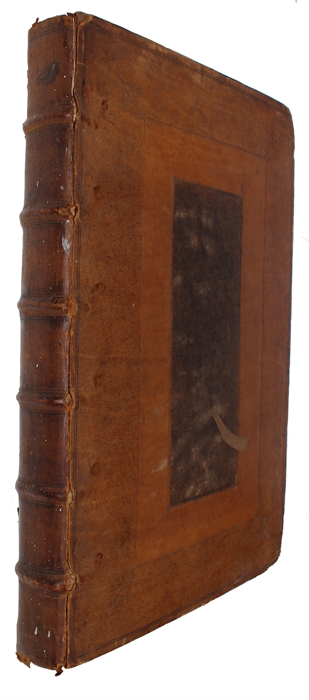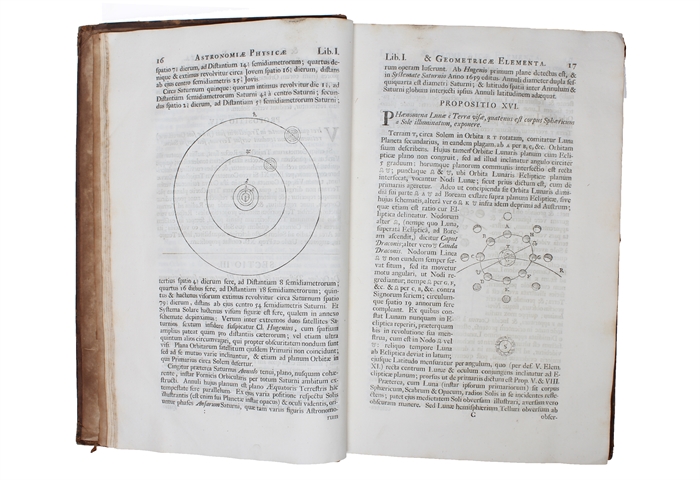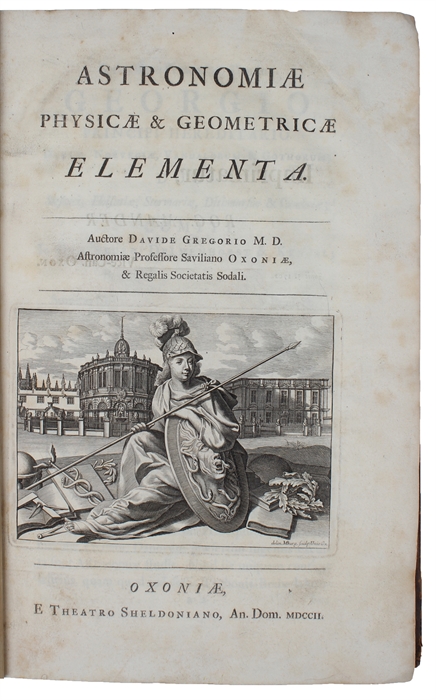WITH THE FIRST PRINTING OF NEWTON'S "LUNAE THEORIA" AND THE FIRST UNVEILING OF NEWTON'S CALSSICAL SCHOLIA
GREGORY, DAVID and (ISAAC NEWTON).
Astronomiae Physicae & Geometricae Elementa.
Oxoniae (Oxford), E Theatro Sheldoniano, 1702.
Folio. Contemporary full calf, raised bands, rectangular blindtooled frames and central panel "mirror" on covers, Cambridge-style binding. leather at joints cracked, but cords intact so that covers not loose. Corners a bit bumped. Light wear to spine ends. Spine a bit rubbed. Pastedowns and flyleaves with browning. Title-page with large engraved vignette (Sheldon Theater). (12),494,(2) pp. With numerous textdiagrams. Very light browning to titlepage and a few marginal brownspots to last leaf, a fine clean copy, printed on good paper with wide margins.
On the verso of the title-page is pasted the book plate of Sir William Baird of Newbaith. He habitually pasted his armorial bookplate on the verso of the title-pages of the books in his large and fine library.
First edition of the first text book of astronomy based on Newtonian principles. Apart from its importance in the remodeling of astronomy in conformity with physical theory, the work is of the utmost importance as a source book - it contains the FIRST PRINTING OF NEWTON'S PAPER ON LUNAR THEORY ("Lunae Theoria Newtoniana", pp. 332-336) as well as the FIRST EXPOSITION OF NEWTON'S CLASSICAL SCHOLIA, which Newton himself considered an important part of his philosophy.
Gregory, a Scottish mathematician, who taught at Edinburgh and Oxford, was one of Newton's closest friends and associates. Newton thought highly of his work and communicated for insertion it in his Lunar Theory. He also permitted Gregory to use the material of that which is known as his "Classical Scholia", which are incorporated into Gregory's preface.
"Newtonian scholars have long been aware of a set of draft Scholia to Propositions IV to IX of Book III of the "Principia". These were composed in the 1690's, as part of an unimplemented plan for a second edition of the work. Since they describe supposed anticipation of Newton's doctrines in the thought of Greco-Roman antiquity, they have been known as the 'classical' Scholia..... Newton's thoughts on these matters were not, however, kept completely concealed. HE PERMITTED DAVID GREGORY TO USE THE MATERIAL EXTENSIVELY in a long historical preface to his "Astronomiae Physicae & Geometricae Elementa" (1702), IF WITHOUT ATTRIBUTION. (It was also available to Maclaurin for his much later work)." (McGuire & Rattansi in "Newton and the Pipes of Pan", 1966).
"It was the first textbook composed on gravitational principles, and remodeling astronomy in conformity with physical theory. Newton thought highly of it, and communicated for insertion in it (p. 332)) his 'lunar theory', long the guide of practical astronomers in determining the Moon's motions. The discussion in the preface, in which the doctrine of gravitation was brought into credit on the score of its antiquity, likewise emanated from Newton." (DNB).
"His thick folio text on foundations of astronomy, Astronomiae...elementa (1702) is a well-documented but unimaginative attempt to graft the gravitational synthesis propounded in the first book and especially the third book of Newton's Principia onto the findings of traditional astronomy. While respected as a source book it is now chiefly remembered for the remarks by Newton on the prisca sapientia of the ancients and their "knowledge" of the inverse-square law of universal gravitation and for the Latin version of Newton's short paper on lunar theory which it reproduces." (DSB).
Babson No. 71. - Houzeau & Lancaster 9240.
Order-nr.: 47776



